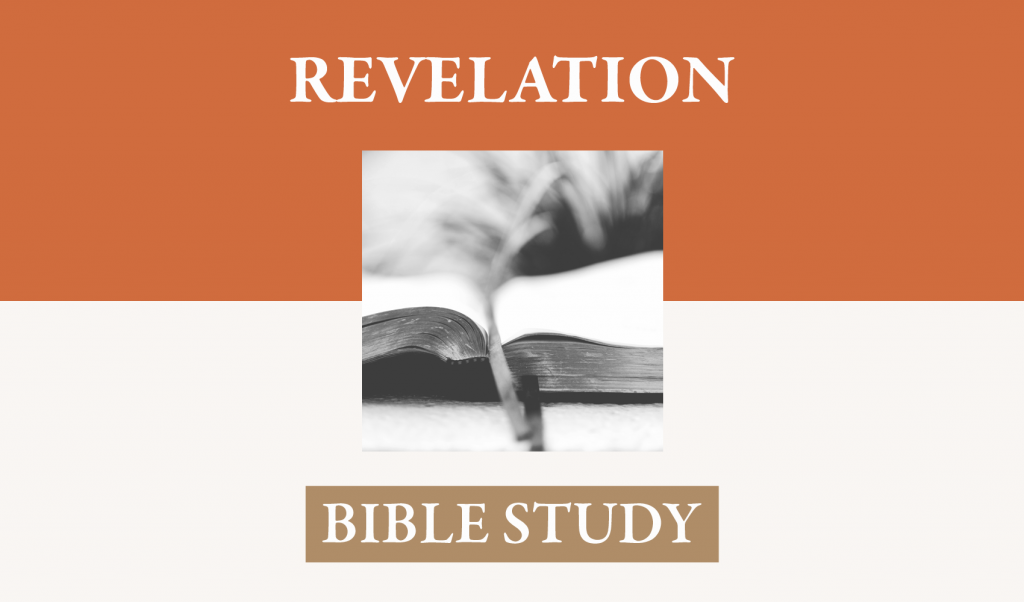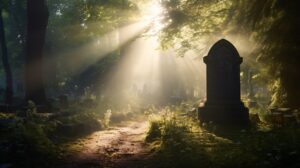Biblical Truth: Because Christ is victorious over death, He is in charge and believers will be victorious in Him.
Looking to Jesus: Rev. 5:1-7.
[1] I saw in the right hand of Him who sat on the throne a book written inside and on the back, sealed up with seven seals. [2] And I saw a strong angel proclaiming with a loud voice, "Who is worthy to open the book and to break its seals?" [3] And no one in heaven or on the earth or under the earth was able to open the book or to look into it. [4] Then I began to weep greatly because no one was found worthy to open the book or to look into it; [5] and one of the elders said to me, "Stop weeping; behold, the Lion that is from the tribe of Judah, the Root of David, has overcome so as to open the book and its seven seals." [6] And I saw between the throne (with the four living creatures) and the elders a Lamb standing, as if slain, having seven horns and seven eyes, which are the seven Spirits of God, sent out into all the earth. [7] And He came and took the book out of the right hand of Him who sat on the throne. [NASU]
[1] Behind this verse is Ezekiel 2:9-10, where a scroll with words of lament, mourning and woe written on both sides is found in the hands of God and shown to Ezekiel. The message of judgment given to Ezekiel provides the background to the scroll and the seven seals here. The scroll was possibly a heavenly book containing God’s redemptive plan and the future history of God’s creation perhaps detailing the prophecies in this book. It would then detail the judgments that will inaugurate the eschaton and provide an end to history and a beginning to the eternal reign of Christ as well as the joy of the people of God. It is important here to note that the events of chapter 6 accompany the opening of the seals and do not constitute the contents of the scroll. The judgments of the seals are preliminary events that lead up to the unfolding drama of the eschaton and the completion of the divine plan. The seven seals point to completeness, focusing on the fullness of the divine plan. It is perfect and is to be unveiled at the perfect time.
[2-4] This particular angel is perceived to be strong here because he makes a proclamation with a loud voice to the world at large as he offers the invitation, Who is worthy to open the book and to break its seals? But there is no response to the invitation because no one in the whole of creation, in heaven or on the earth or under the earth, not a single person was able to open the book or to look into it. This tragic inability was attributable not to lack of physical strength but to moral incompetence. No one was able to open the book because no one was found worthy to do so; and this unworthiness is the evil consequence of sinfulness. The universality of human sinfulness, which is a pervasive theme of Scripture, is forcefully set forth by Paul in Romans 3:9ff., where he insists that there is none righteous, not even one and that all have sinned and fall short of the glory of God. It is no wonder that John began to weep greatly, for there is nothing more deplorable and more calamitous in the story of mankind than our total unworthiness as sinful creatures in the presence of our Maker. Nothing is more lamentable than the fact that by our own ungodliness we have deprived ourselves of all worthiness.
[5] The weeping Apostle is addressed by one of the elders, who as such is representative of the redeemed of mankind, and who is presumably the same elder that speaks to him in 7:13 below. Bidding John to cease weeping, he points him to the incarnate Son, now enthroned in glory, who has overcome the enemy and, being alone without sin, is alone worthy to unseal the book. In Him the human tragedy has been turned to triumph. All weeping ceases when we look away from our defeated and unworthy selves and put out trust in Him through whom all tears are wiped away. The dignity of the victorious Lord is defined in a double title. First, His designation as the Lion that is from the tribe of
[6-7] The description of the Lamb as being between the throne and the elders means that He is the central figure on whom the attention of all is focused. The glorified Redeemer is frequently spoken of as the Lamb in this book. It is a designation that is grounded in the sacrificial typology of the Old Testament, with particular reference to the Passover lamb of Exodus 12 and the sacrificial lamb in the Aaronic system symbolizing the innocent and unblemished victim offered up for sinners. This significance is classically expressed in Isaiah 53 in which it is said of the Lord’s Servant that the Lord has caused the iniquity of us all to fall on Him and that He is like a lamb that is led to slaughter [Isa. 53:6f.]. As perceived by John, the Lamb was as if slain, that is, bearing the marks of a violent death. The cross of
Reigning with Jesus: Rev. 5:8-10.
[8] When He had taken the book, the four living creatures and the twenty-four elders fell down before the Lamb, each one holding a harp and golden bowls full of incense, which are the prayers of the saints. [9] And they sang a new song, saying, "Worthy are You to take the book and to break its seals; for You were slain, and purchased for God with Your blood men from every tribe and tongue and people and nation. [10] You have made them to be a kingdom and priests to our God; and they will reign upon the earth." [NASU]
[8] This scene indicates the prostration of all creation in adoration and gratitude before the Lamb. Each of the elders is holding a harp, the instrument whose music was associated with the offering of praise to God, and golden bowls full of incense. The fragrant smell of incense are the prayers of the saints. In the ceremonial of the tabernacle, and later the temple, every morning and evening fragrant spice was burned on the altar of incense, which, located in the Holy Place, was overlaid with gold, to provide a perpetual incense before the Lord [Ex. 30:1-8]. In this way the prayer of God’s people ascending like an acceptable fragrance was symbolized. The psalmist’s petition, may my prayer be counted as incense before You, expressed his desire to find acceptance with God [Ps. 141:2]. So also for the people as a whole, the time of incense was the time of prayer. That the prayers of the saints as they strive and suffer on this earthly pilgrimage are pleasing to their Heavenly Father, who lovingly cares for them, is not to be doubted. But in this vision the golden bowls are filled with the fragrant prayers of the church of the redeemed in glory. It would be wrong, however, to insist on making a rigid distinction. The glory revealed to John is also a glory yet to be revealed, in that he is still a pilgrim on this earth. He witnesses the fulfillment without yet himself being fully part of it. What he sees is reality in the truest sense; yet for him the anticipatory aspect of the revelation is, for the time being, unavoidable. So our prayers hereafter in the glory of the new creation are preceded by our prayers here and now.
[9-10] The new song is a eulogy of the Lamb whose worthiness to take the book and to break its seals has been established through His blood-shedding for the redemption of mankind. Exhortations to sing a new song to the Lord, whether for His unfailing goodness or at times of marvelous deliverance and joyful celebration, are familiar to us in the Old Testament. The praise of the Lamb is a song that will never grow old, because the wonder and joy of this salvation will never pall, because, indeed, in the new heaven and earth no one and nothing becomes old. Newness is the hallmark of the renewed creation in which there is no staleness, no slowing down, and no wearing out. The Lord’s redeemed people are evermore new creatures for whom the new has come. As citizens of the new Jerusalem they hear the Lord’s new name [2:17], and they rejoice for ever in the realization of the Creator’s proclamation, Behold, I am making all things new [21:5]. This newness is both the restoration of the newness of creation as it first came from the hand of God and, what is more, the enhancement of that newness with the transcendental glory for which it was designed and predestined. The purpose of the Son’s incarnation was that He might be slain as a lamb.
Responding with Worship: Rev. 5:11-14.
[11] Then I looked, and I heard the voice of many angels around the throne and the living creatures and the elders; and the number of them was myriads of myriads, and thousands of thousands, [12] saying with a loud voice, "Worthy is the Lamb that was slain to receive power and riches and wisdom and might and honor and glory and blessing." [13] And every created thing which is in heaven and on the earth and under the earth and on the sea, and all things in them, I heard saying, "To Him who sits on the throne, and to the Lamb, be blessing and honor and glory and dominion forever and ever." [14] And the four living creatures kept saying, "Amen." And the elders fell down and worshiped. [NASU]
[11-12] Added to the praise of the created order and of redeemed mankind is the loud music of the angelic host, whose number is beyond calculation. Thus in Hebrews 12:22 the beneficiaries of the new covenant are said to have come to the city of the living God, the heavenly
[13-14] The homage of praise and worship is offered by every created being, each with its ordered place and function in the harmony of the whole, to Him who sits on the throne, that is, to God the Creator of all, and to the Lamb, that is, to the incarnate Son in whom God is the Redeemer. The fourfold structure of the homage serves to emphasize its universality: blessing and honor and glory and dominion. The concluding Amen is the confirming utterance of all creation under the representation of the four living creatures, while the elders prostrated in worship represent the redeemed of mankind, who, formed in the divine image, are the creatures uniquely equipped to approach God in a personal, spiritual, and rational relationship.
Questions for Discussion:
1. What is the meaning of the titles: Lion of Judah and Root of David? Why is Christ alone worthy to open the book? What is the meaning of seven horns, seven eyes, seven Spirits?
2. In 5:8-10, list all the results of our redemption by the Lamb. What do the harp and golden bowls full of incense indicate as the only true response to our redemption? In what sense is our redemption for God? What does it mean to you that you will be in eternity a kingdom and priests to our God?
3. List the seven attributes of the Lamb mentioned in 5:12. Each day of this next week, take one of these attributes and make it the focus of your praise and worship of the Lamb for that day.
References:
The Book of the Revelation, Philip Hughes, Eerdmans.
Revelation, Grant Osborne, Baker.





















